Gurdwaras in Punjab, Pakistan
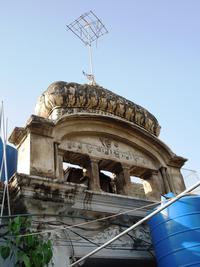 Gurdwara Baradari Rawalpindi
Gurdwara Baradari Rawalpindi
The Partition of Punjab in 1947 didn’t just result in the uprooting of hundreds of thousands of Sikhs from their ancestral homes; it also resulted in the separation of the Sikh community from hundreds of historical Gurdwaras and landmarks. Places like Nanakana Sahib and Panja Sahib which are integral to the Sikh heritage were left behind. Ironically, several historical Gurdwaras, such as those in Ghavindi, Hudiara, Jahman and Kartarpur Sahib are as close as 5 km from the international border. Some of these Gurdwaras like Kartarpur Sahib can even be seen in the distance when standing at the border - so close yet so very far.
It was recently announced that the Pakistan Government would be permitting access to four more Gurdwaras: Gurdwara Bhai Joga Singh and Gurdwara Bhai Biba Singh in Peshawar, Gurdwara Babe di Ber in Sialkot and Gurdwara Bebe Nanaki in Dera Chahal. It was also announced that Hassan Abdal, the site of Gurdwara Panja Sahib, would be declared a “Holy City.”
Although these are certainly positive steps and the Pakistan government has in recent years made serious efforts to renovate and open other Gurdwaras to the Sikh community (such as Gurdwara Rori Sahib Emnabad and Gurdwara Kartarpur Sahib), there remain many other historical Gurdwaras associated with the Sikh Gurus which have either been lost or are currently in a sad state of encroachment and neglect.
In 1998, Iqbal Qaiser published the book “Historical Sikh Shrines in Pakistan” which traced the present state of close to 200 historical Gurdwaras in Pakistan. The book included colour photographs and a description of what the Gurdwara buildings were currently being used for. Many of those Gurdwaras and pictures have been put onlinehere.
With the advent of the internet and services like Google Earth and Panoramio, it has become easier to track some of the lesser known Gurdwaras in Pakistan. Often, local photographers upload pictures of the sites as well as descriptions.
Using Qaiser’s book as well as other resources, we’ve tried to track down some of the lesser-known Gurdwaras using online tools and we were surprised at the results. Below are some of the Gurdwaras we managed to find (click on the pictures to view the larger versions):
Gurdwara Kair Sahib, Jaisak
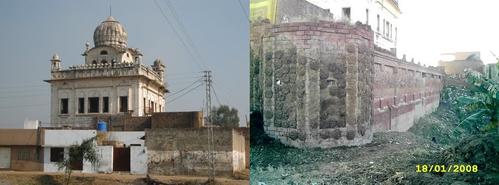 Gurdwara Kair Sahib This Gurdwara in the memory of Guru Nanak Dev Ji is located in the village of Jaisak which is located on the main road from Mandi Bahauddin to Marala. This beautiful Gurdwara was built at the time of Maharaja Ranjit Singh. It is now being occupied by a high ranking police official who lives in the Parkash Asthan and denies entry to visitors. The Gurdwara still towers over the village but it is in a dilapidated state.
Gurdwara Kair Sahib This Gurdwara in the memory of Guru Nanak Dev Ji is located in the village of Jaisak which is located on the main road from Mandi Bahauddin to Marala. This beautiful Gurdwara was built at the time of Maharaja Ranjit Singh. It is now being occupied by a high ranking police official who lives in the Parkash Asthan and denies entry to visitors. The Gurdwara still towers over the village but it is in a dilapidated state.
Gurdwara Chota Nankiana, Dipalpur
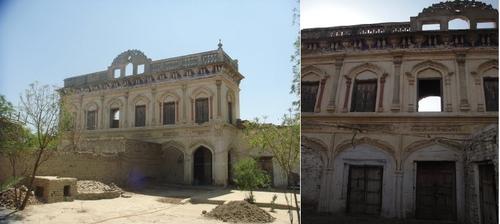 Gurdwara Chota Nankiana A Gurdwara in memory of Guru Nanak stands outside the town of Dipalpur on the south-eastern side. It is called Gurdwara Chota Nanakiana Sahib. Guru Dev Ji made his abode under a dead pippal tree which became green again and is standing even today.
Gurdwara Chota Nankiana A Gurdwara in memory of Guru Nanak stands outside the town of Dipalpur on the south-eastern side. It is called Gurdwara Chota Nanakiana Sahib. Guru Dev Ji made his abode under a dead pippal tree which became green again and is standing even today.
The Gurdwara building is currently not in a good state and could be lost if care is not quickly given to it.
Gurdwara Rori Sahib, Jahman
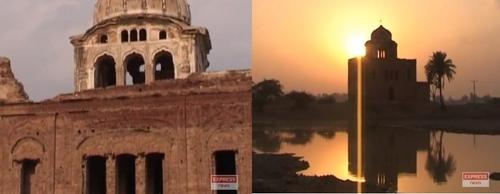 Gurdwara Rori Sahib Located approximately 2.5km from the Indo-Pak border, across from Bhikiwind, this Gurdwara commemorates the visit of Guru Nanak. Guru Nanak’s maternal grandparents lived close by in Dera Chahal.
Gurdwara Rori Sahib Located approximately 2.5km from the Indo-Pak border, across from Bhikiwind, this Gurdwara commemorates the visit of Guru Nanak. Guru Nanak’s maternal grandparents lived close by in Dera Chahal.
This was a beautiful double story Gurdwara built by Bhai Wadhawa Singh. It is now in a sad state of neglect.
There is a local belief that the Gurdwara is ‘haunted’ and the site was the subject of a “paranormal investigation” on a Pakistani television show. The episode can be seen HERE.
Located in Gujranwala district, this Gurdwara was built in the memory of Guru Hargobind Sahib. Guru Hargobind encouraged the villagers to give up the use of tobacco and smoking.
The Gurdwara’s building remains very beautiful and the words “Bandi Chhor da Darbar” or the “Court of the Emancipator” ie. Guru Hargobind remain above the entrance. Currently however, the Gurdwara’s building is being severely misused and animals are fed directly outside of it.
Gurdwara Kotha Sahib, Wazirabad
 Gurdwara Kotha Sahib This Gurdwara marks the visit of Guru Hargobind Sahib. The Gurdwara’s architecture was very unique with the elongated central dome. The rectangular ground floor has only one entrance and no windows. The first floor has three windows on the façade; the width of the central one is three times that of the one on either side of it. The room has also a window each on the side walls. It has a dented cornice. The second floor consists of three domed rooms, the central one is slightly bigger than the others.
Gurdwara Kotha Sahib This Gurdwara marks the visit of Guru Hargobind Sahib. The Gurdwara’s architecture was very unique with the elongated central dome. The rectangular ground floor has only one entrance and no windows. The first floor has three windows on the façade; the width of the central one is three times that of the one on either side of it. The room has also a window each on the side walls. It has a dented cornice. The second floor consists of three domed rooms, the central one is slightly bigger than the others.
The Gurdwara is in a sad state of repair and is occupied by several families. Access is denied to visitors and the structure has been altered to suit the needs of the current inhabitants.
Gurdwara Bhai Banno, Mangat
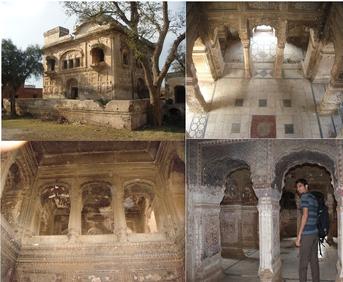 Gurdwara Bhai BannoThis Gurdwara in Mangat (near Mandi Bhauddin) is in memory of Bhai Banno, a Sikh of Guru Arjan who was tasked with binding the first saroop of the Adi Granth. On the way to doing this, he prepared a second copy but included several extraneous compositions and for this reason his copy was called the “Khari Bir”. Bhai Banno’s family lived in this village until Partition and then moved to Kanpur in India.
Gurdwara Bhai BannoThis Gurdwara in Mangat (near Mandi Bhauddin) is in memory of Bhai Banno, a Sikh of Guru Arjan who was tasked with binding the first saroop of the Adi Granth. On the way to doing this, he prepared a second copy but included several extraneous compositions and for this reason his copy was called the “Khari Bir”. Bhai Banno’s family lived in this village until Partition and then moved to Kanpur in India.
This Gurdwara was built during Sikh rule by the royal command of Maharaja Ranjit Singh. The building is magnificent and beautiful even today, despite decades of neglect. The Gurdwara design is similar to Sri Darbar Sahib Amritsar and Gurdwara Tarn Taran Sahib and shows what would happen if these places were neglected. Many of the wall paintings and frescoes have now been vandalized and painted over. Although a primary school was housed in this Gurdwara in the past it now appears to be empty. There is a vegetable market outside the Gurdwara.
Gurdwara Bhai Than Singh, Kot Fateh Khan (Attock)
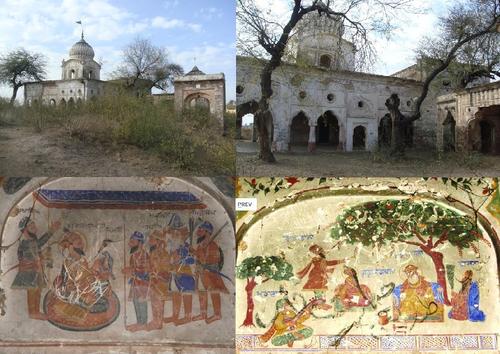 Gurdwara Bhai Than SinghThis Gurdwara in Kot Fateh Khan in the Attock district is named after Bhai Than Singh, a pious Sikh who resided at that place.
Gurdwara Bhai Than SinghThis Gurdwara in Kot Fateh Khan in the Attock district is named after Bhai Than Singh, a pious Sikh who resided at that place.
Today, the Gurdwara is revered by locals as the shrine of “Baba Thana” or simply “Sultan”. Locals worship at this shrine like other shrines of Muslim Pirs and come to have their wishes fulfilled.
Many beautiful wall pictures depicting Sikh history can be seen on the walls, though most are badly defaced.
An article on this gurdwara and other shrines in Kot Fateh Khan was published in the Pakistani press recently.
It is essential that the Sikh community encourage the Pakistan government to protect and restore these historic Gurdwaras before they, like many others before them, are forever lost.

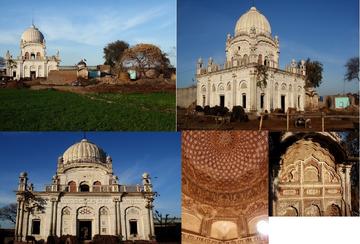
No comments:
Post a Comment